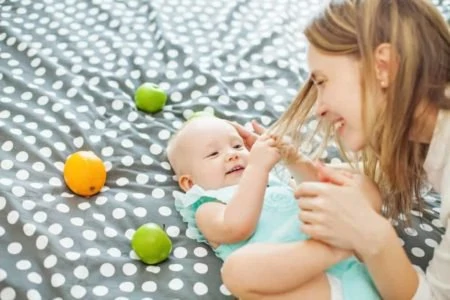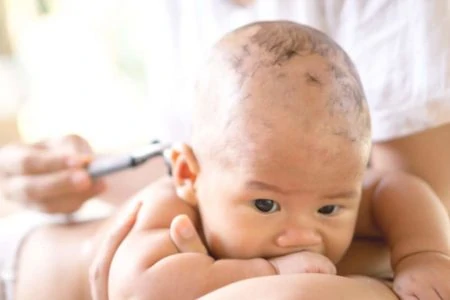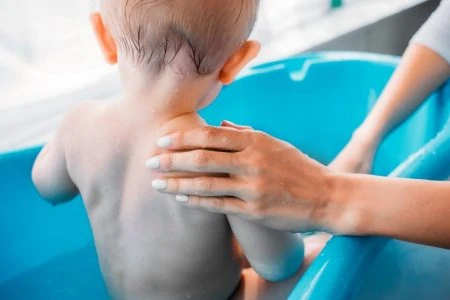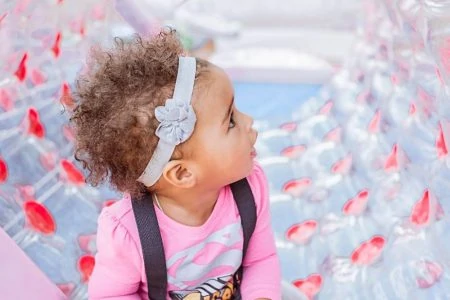Many new moms are concerned about when and how to wash their newborn’s hair. You may have heard that babies hate bathing or having their hair washed, so you may expect the experience to be painful for both of you.
As moms ourselves, we can identify with those feelings. So we created this comprehensive guide to help you break down the process into simple steps that are easy to follow.
We’ll also discuss when you need to start washing your baby’s hair and how often you should break out the shampoo.
Armed with our easy tips and advice from our medical team, you’ll be a baby-hair-washing pro in no time. You might even find yourself looking forward to shampoo night, as it can be a sweet bonding time with your baby.
Key Takeaways
- Start washing your baby’s hair immediately after birth, but only once or twice a week.
- Regular washing can help prevent cradle cap, ringworm, and dandruff in babies.
- To wash your baby’s hair, use a gentle, moisturizing, baby-safe shampoo and a soft washcloth.
- Dry your baby’s hair with a soft towel, a soft brush, or a blow-dryer on a cool setting.
When Can I Start Washing My Baby’s Hair?
You can wash your baby’s hair immediately after birth. In the hospital, a nurse will often give your baby their first bath to clean the skin before dressing them.
Many moms feel hesitant about washing their baby’s hair for the first time — I know I did. However, with a few tips and tricks, you’ll soon discover it’s nothing to stress about.
Newborns don’t need a bath every day. It’s only necessary to wash their hair once or twice a week (1). Even if your baby doesn’t have much hair, it’s still important to gently wash the scalp to remove excess oil.
If you feel that your baby’s hair might need a little cleanse in between, you can simply use a washcloth and water. Wet the cloth and wring it out, then gently wipe your baby’s hair. This should do fine until the next shampoo session.
When parents inquire about washing their infants’ hair, I recommend they simply rinse the scalp during the baby’s bath. If there are no scalp problems, there is no need to wash with shampoo daily. For infants who are lucky enough to have a full head of hair at birth, it’s OK to use a tear-free infant shampoo up to a couple of times a week.
Editor's Note:
Dr. Leah Alexander, MD, FAAPCradle Cap — Can Regular Washing Help?
Infantile seborrheic dermatitis, more commonly known as cradle cap, is a dandruff-like condition that many babies develop. It’s neither harmful nor contagious, and the look of it may bother you more than your baby.
The causes of cradle cap are not precisely known. Some studies suggest it’s caused by the hormones that rush through the baby and mother before birth. The hormones can cause an overproduction of sebum, which is found in the oil glands.
Others say that a yeast called “Malassezia” is to blame. Malassezia naturally grows in the sebum along with other microbes. Some pediatricians treat cradle cap with an antifungal serum for this reason (2). The AAP has additional advice regarding cradle cap.
Many doctors will recommend you wash your baby’s hair and scalp more regularly when cradle cap is diagnosed. Keeping the hair and scalp clean could help remove excess oil.
Because cradle cap is an oily type of rash, I do not recommend using oils to treat it. I commonly discuss this issue in practice and often hear of a grandmother or extended relative who has urged the parents to put oil on the scalp. Unfortunately, once the oil is absorbed into the pores of the scalp, the flaking increases.Instead, I suggest using the “Classic” form of Head & Shoulders shampoo (as opposed to the many other versions available on the market) to wash the scalp every other day for one week. This is easiest to do with the infant lying on their back but inclined a bit so the shampoo does not end up in their eyes. Rinse by pouring water from behind the infant’s head to avoid their eyes as well.
Editor's Note:
Dr. Leah Alexander, MD, FAAPOne of the best ways to remove the scales is by softening them before a bath using an oil or petroleum jelly. After the bath, gently brush your baby’s hair with a soft brush.
Benefits of Washing Your Baby’s Hair
Along with having a clean head, there are other benefits to washing your little one’s hair regularly.
1. Could Prevent Ringworm
Ringworm is a common skin infection. In babies and children, it’s likely to appear on the scalp. Ringworm is highly contagious, but fortunately, it has nothing to do with worms; it’s actually a fungal infection.
The infection causes a ring or oval shape to form, and the area is usually dry, red, and itchy. Your baby’s pediatrician may prescribe an antifungal cream or ointment or a special shampoo. However, for the infection to completely clear, your baby might also need oral treatment (3).
One way you may be able to prevent ringworm is by regularly washing your baby’s hair and scalp.
2. May Prevent Dandruff
Although dandruff is very similar to cradle cap, it isn’t quite the same condition.
These are some common causes of dandruff:
- Eczema.
- An excess of oil.
- Dry scalp.
- A fungal infection.
Dandruff is not harmful or contagious, but it can be itchy — especially it’s caused by eczema or dryness.
Using a moisturizing shampoo regularly can help prevent or reduce the effects of dandruff’s.
However, avoid using shampoo if your baby has eczema on the scalp. Instead, contact your baby’s pediatrician and follow their advice. They may suggest using an emollient shampoo instead since these are soothing for the skin.
If the cause is excess oil, try washing your baby’s hair and scalp more often (4).
How to Wash Your Baby’s Hair
Now that you know some of the benefits of washing your little one’s hair, let’s learn how to do it correctly. Here’s our easy-to-follow guide for washing your baby’s hair — without tears.
What you need:
- A tub, basin, or sink.
- A towel.
- A washcloth.
- A moisturizing, baby-safe shampoo.
- Optional: Moisturizer or oil.
1. Fill the Tub
Fill the tub with around two to four inches of warm water. If you have a thermometer, check that the water is about 100 degrees Fahrenheit.
Don’t have a thermometer handy? Use your elbow to test it. The water should feel warm but not hot.
2. Bathe Your Baby
Bathe your baby as you usually would. I like to finish off with washing the hair since wet hair can make your baby cold quicker.
When it’s time to wash your baby’s hair, wet it a little using your hand, a cup, or a washcloth, making sure water doesn’t trickle down their face. Take a small amount of baby shampoo and gently lather it into the hair. You should never rub vigorously.
Use your hand, a cup, or a washcloth to rinse out the shampoo carefully but thoroughly. An excellent way to do this is by alternating between pouring a little water and sweeping front to back with your hand.
If you’re worried the suds will get in your baby’s eyes, use the washcloth. Wet it and gently wipe your baby’s hair clean.
3. Get Out and Get Dressed
Once you’re done, lift the baby out of the tub and pat them dry with a soft towel right away. Gently rub their hair with a towel. Dress them appropriately, and snuggle up for some relaxation time.
When you’re happy, your baby is happy. If you’re feeling nervous, chances are your baby will feel your vibes — so try to stay calm.
Practice makes perfect. Sooner or later, you’ll be a whizz at the process, and your child may even look forward to having their hair washed.
Is It Necessary to Dry Your Baby’s Hair?
Whether you dry your baby’s hair after a bath will depend on your personal preference. Some parents like to leave it to dry naturally, while others prefer otherwise. If it’s cold out, you may choose to get it done right away.
A baby can lose a lot of body heat through their head. However, they can also overheat if their head is covered for too long. Investing in a hooded towel is an excellent way to take your little one from the bath to your changing area without them getting chilled.
How to Dry Your Baby’s Hair
If you want to do a little more than merely letting your baby’s hair dry naturally, here are a couple of methods:
1. Towel Dry
After a bath, make use of a soft towel to stroke your baby’s hair gently. The towel will soak up any remaining water.
2. Use a Soft Brush
If your baby has thin hair, simply stroking it a couple of times after patting it with a towel can remove excess moisture. However, if your baby has more hair, this method could be tedious and not so successful.
Some of my parents who have infants with course hair will brush the hair with baby lotion to reduce the tangles. If there are signs of cradle cap, I discourage this practice as the excess oil can worsen the condition.
Editor's Note:
Dr. Leah Alexander, MD, FAAP3. Blow-Dry
Some parents want to use a blow-dryer after a bath, but if you do, be very careful. Blow-dryers can become very hot. I’ve burned myself a couple of times — blame an evil cocktail of the morning rush and a crying toddler.
Babies have sensitive skin that can burn very easily.
If you do want to use a hairdryer, here’s how to do it safely:
Set the Temperature
It’s crucial that you use a dryer with a “cool” setting.
Keep a Safe Distance
Keep the dryer at least 12 inches away from your baby’s head. Chances are your baby’s hair is thin, so it doesn’t need more than a minute to dry anyway.
Test the temperature on the inside of your arm first. Try to check it at the same distance as you would on your little one.
Use a Brush
You can use a brush, comb, or your fingers to gently stroke the hair while drying. This will speed up the process and avoid tangles.
Never direct the air straight into your baby’s face. This could startle your baby and make them fear bathtime in the future.














